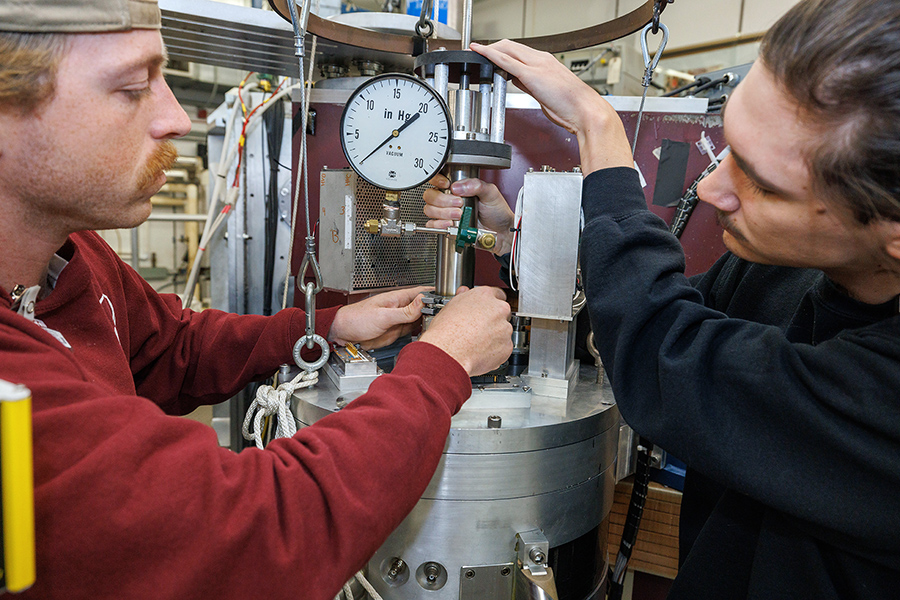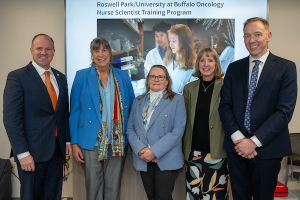“I thought I just needed to get active again, so I started working out at least four days a week, but exercising didn’t help,” said Washburn. “I could barely keep up with friends on hikes, and I found myself significantly out of breath, even when walking my dogs around the neighborhood.”
When Washburn could not manage going up the flight of stairs in his own home, he knew something was significantly wrong.
Washburn and his wife, Melissa, went to the emergency department out of concern he was having a heart attack. Testing in the ED, including an EKG and CT scan, identified pulmonary embolisms, or blood clots, in both of Washburn’s lungs.
He began taking blood thinners, started on supplemental oxygen and was referred to pulmonary rehab.
“Unfortunately, after a few weeks of treatment and time in pulmonary rehab, I began to plateau, and during some exercises, my oxygen levels would just plummet,” said Washburn.
Upon realizing blood thinner medication and pulmonary rehab were not addressing his symptoms, Washburn’s doctor recommended additional imaging and a catherization on the right side of the heart.
The test results confirmed the root cause of his health issues: chronic thromboembolic pulmonary hypertension (CTEPH), which is caused by blood clots in the pulmonary arteries that can lead to right sided heart failure.
A Colorado resident, Washburn was referred to Nick Kim, MD, section chief of Pulmonary Vascular Medicine at UC San Diego Health, who determined Washburn was a candidate for pulmonary thromboendarterectomy (PTE) surgery.
In July 2024, Washburn was the 5,000th patient to undergo a PTE surgery at UC San Diego Health. The region’s only academic medical center pioneered the surgery and has performed the most in the world.
During the innovative procedure, surgeons remove blood clots and scarring from major blood vessels in the arteries of the lungs to restore blood flow.
To remove the clots, surgeons must see clearly into the lungs’ tiny arteries, which requires operating without any blood present. To achieve this, the patient’s body is cooled using a heart-lung machine. Once the body temperature reaches approximately 64 to 68 degrees Fahrenheit, blood flow is stopped and blood volume is drained in a reservoir to create a bloodless surgical field.
Using sophisticated techniques and specialized instruments, the surgeon meticulously removes the clots without perforating the paper-thin artery wall. These clots are fibrous white scar tissue, which when arranged on a surgical table, take the shape of the inner branches of the lung’s arteries.
On average, a PTE procedure lasts approximately 9 to 10 hours.
“Qualifying for PTE is a very complex determination that is managed by a highly qualified, multidisciplinary team, which is what sets us apart as a leader in this field,” said Kim, clinical professor of medicine at University of California San Diego School of Medicine. “It is incredible to see how quickly this surgery helps individuals who may have been dealing with symptoms of CTEPH for years. The transformation we witness first-hand is inspiring.”
“Mr. Washburn was a candidate for PTE for many reasons, but mainly because of the location in which the clots formed in his lungs,” said Michael Madani, MD, professor and the John G. Pickard Endowed Chair in Cardiac Surgery at UC San Diego School of Medicine. “It was an honor to perform his surgery. He did extremely well, and we were all so pleased to celebrate the incredible 5,000th milestone with him, his family and our team.”
According to Madani, surgical director of the CTEPH program at UC San Diego Health, the clots in Washburn’s lungs were both segmental and subsegmental level clots, which means they were within very small arteries of the lung tissue itself.
“We are one of the few places in the world that can perform PTE at both a segmental and subsegmental level,” added Madani, chief of Cardiovascular and Thoracic Surgery and executive director of Cardiovascular Institute-Surgery at UC San Diego Health.
One of the leading causes of right-sided heart failure, CTEPH can be deadly if left untreated. It is also relatively rare; it’s estimated that there are at least 3,000 new cases of CTEPH in the United States each year, according to the American Lung Association.
CTEPH is likely more prevalent than currently recognized because the symptoms — such as shortness of breath, fatigue or discomfort — are nonspecific. Patients, including Washburn, often are originally misdiagnosed with more common conditions, such as asthma, leading to delays in appropriate treatment.
“We offer the most state-of-the-art CTEPH therapies, starting with surgery to interventional catheterization procedures, and targeted medical therapy — often combining them to provide patients with the best possible outcome,” said Kim, pulmonologist and medical director of the CTEPH program at UC San Diego Health.
For individuals who are not candidates for PTE surgery, UC San Diego Health offers balloon pulmonary angioplasty (BPA), as well as supportive and pulmonary hypertension targeted medical therapies.
UC San Diego Health is the only health care system in the region to offer BPA. The minimally invasive technique uses x-ray imaging to guide wires and a balloon to the site of the blood clot or blockage. The balloon is then inflated to disrupt the blood clots and the blockages are pushed into the walls of the arteries. Afterwards, the balloon is deflated and removed through the same catheter.
In June 2024, UC San Diego Health completed 1,000 BPA procedures, the most in the nation.
“We are extremely proud to have achieved 1,000 BPAs, coincidentally around the same time as the 5,000th PTE milestone. Together, we provide comprehensive treatment options for our patients so they can get the help they need for their specific form of CTEPH,” said Ehtisham Mahmud, MD, Edith and William Perlman Endowed Chair in Cardiology at UC San Diego School of Medicine, chief of Cardiovascular Medicine and executive director of the Cardiovascular Institute-Medicine at UC San Diego Health.
Patients receiving BPA need to undergo approximately four to six treatment sessions to remedy their CTEPH.
According to Mahmud, also director of interventional cardiology and the cardiac cath lab at UC San Diego Health, patients typically experience a noticeable improvement in overall health and ability to breathe after each session.
Until the development of procedures like PTE and BPA, the only treatment available for CTEPH was lung transplantation. Now, UC San Diego Health experts perform approximately 200 PTE surgeries and 175 BPA procedures annually.
The pulmonary vascular disease program at UC San Diego Health represents the remarkable efforts of a team of physicians, surgeons, anesthesiologists, nurses, respiratory therapists and social workers who combine their expertise and passion into a world-class program.
Washburn and his wife Melissa are now making plans for an international trip that will be timed to recognize the one-year anniversary of his surgery. As avid travelers, they try to organize a special vacation each year, but plans were halted due to Washburn’s health challenges.
“The biggest hurdle I have in front of me now is recovering, but we’re seeing the light at the end of the tunnel, and we’re getting closer every day,” said Washburn. “We were so fortunate to have received such incredible care. Melissa and I have a lot of exciting things to look forward to in our future.”
# # #



